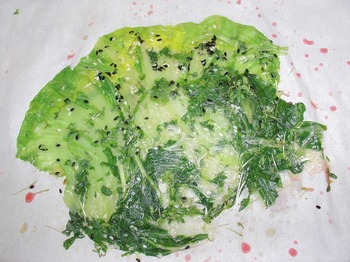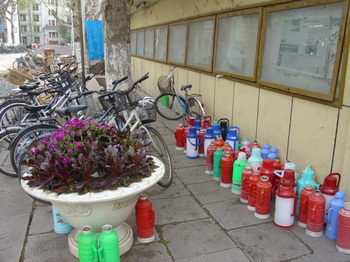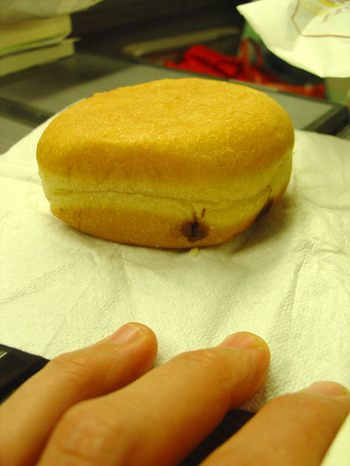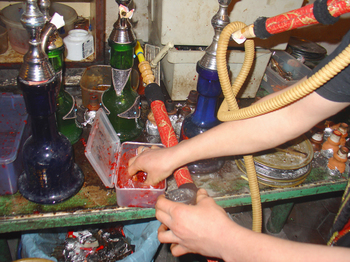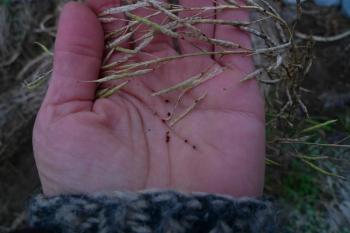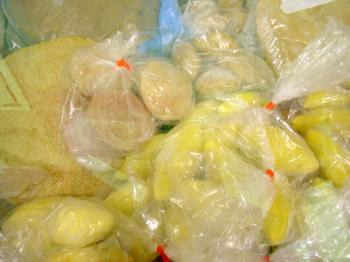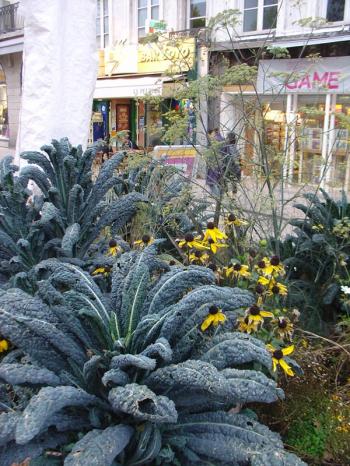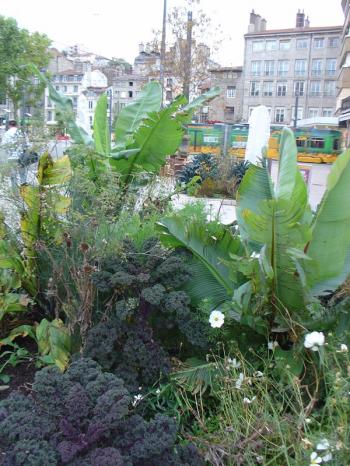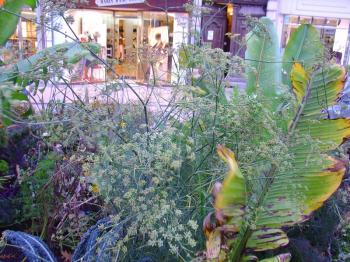Kouba Libre
Supermarket Babylon
October 26, 2007
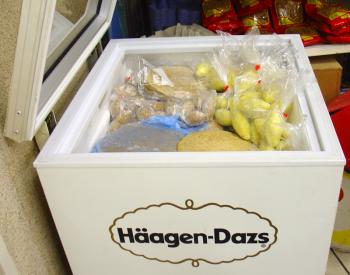
Homemade ice kouba in a sponsored freezer
In the grain section there are more than 20 sorts of rice and then there’s a formidable bulgur department. How often does one get to write that, formidable bulgur department, but there is one. Never mind the lack of competition, Babylon is hands down the best Iraqi supermarket in Rotterdam.
In the non-food bits there’s more or less anything you’d want to outfit a home hammam and an extensive henna assortiment for hair, hands and nails. And for the guys there’s every imaginable spare part for a water pipe and an entire shelf filled with myrrh.
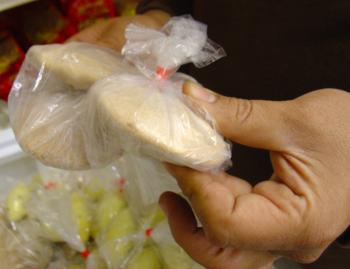
Bags and sacks of cracked wheat dumplings
Of course I’m here for the pickles of the house, with the secret ingredient that isn’t sumac. Totally delicious and made with love. And there’s an entire freezer devoted to homemade dumplings, where rice dukes it out with bulgur. Formidable bulgur.
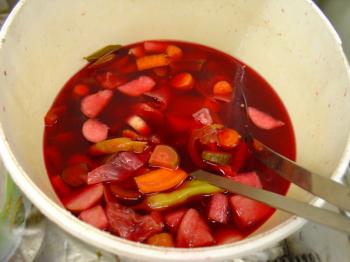
The secret ingredient isn’t sumac
In Hashim’s shop stocked with stuff from the Middle East, Central Asia and several countries to the right of the Stans, Supermarket Babylon is tiny but you can lose yourself for hours. I love that this place has been put together in a geo-politically poetic way and that buttinsky fellow customers spout home-sick recipes when you wonder aloud how to spell kouba, (the dumplings made of bulgur or rice).
debra at 0:59 | Comments (2) | post to del.icio.us
Water, pure thyself
October 23, 2007
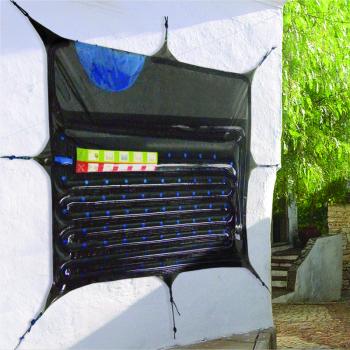
Trickle-down theory, solar disinfection water purifier by Herman Lijmbach, image used with permission
Gawd knows I’m a sucker for water purification, so even though there was a goodly handful of other wonderful work and pretty thingy-thingies at the Design Academy Eindhoven’s graduation show last weekend, I was most impressed with Herman Lijmbach’s solar disinfection (SoDis) water purifier. Spanned across a wall to receive the sun’s full attention, it can clean nearly 5 litres per hour, a day’s worth of drinking water for 10-15 people. Lijmbach decided on a humanitarian project for his exam work and developed the purifier based upon a process called SODIS (solar water disinfection), a simple technology used to improve the microbiological quality of drinking water through solar radiation, destroying the pathogenic microorganisms that cause waterborne diseases.
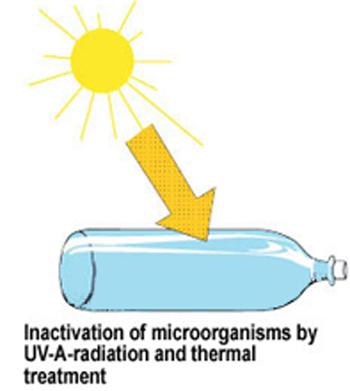
Easy as pie, put some water in the sun for 6 hrs, and bottoms up, image from SODIS website used entirely without permission
Good old-fashioned sunlight is used to treat contaminated water through two synergetic mechanisms: radiation in the spectrum of UV-A (wavelength 320-400nm) and increased water temperature. If the water temperature rises above 50°C, the disinfection process is three times faster. Lijmbach’s prototype can hold up to 30 litres and once the water has passed through the entire tube system (in roughly 1,5 hours) it’s been exposed to so much UV-A and heat that the water has been effectively pasteurised.
The water purifier is designed to work well in all situations where (water) infrastructure is compromised - and y’all know that’s not just for developing regions anymore. Factor in the possibility of a natural disaster, and compromise is easy. I’d like to see versions of Lijmbach’s purifier tested on the rich and fair at campsites or in remote and natural locations where it would be a darn shame to set up water infrastructure in the first place. With production costs at only about € 3,- per purifier, broad field-testing could be as simple as one hand washing the other, or am I just talkin’ hippy-talk?
In any case Lijmbach’s SoDis is ready for pilot projects, and he’s connected to enough field workers in different compromised water infrastrucutre zones to be able to do so. The first steps will be to find a way to make a small industrial series and to get a sufficient body of testing models with a consistant level of quality.
I love the light design approach and even think the object itself is beautiful. One can imagine this working well in combination with a yurt both white and fair by the river (deep and audible sigh) where the purifier placed on the sloping roof could be dragged around for exposure to the full force of the sun.
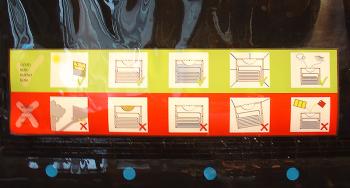
SODIS infograms from left to right: do not place in shade, do not add urine (or champagne), do not drink until process is complete, do not tilt, and either do not clean with amonia and bleach or do not add ketchup and mustard.
Grey (and black)water fetishist that I am, when I asked Lijmbach how clean the initial water has to be for the purifier to work he assured me that as long as the pollution was biological, the purifier would clean it. ‘Salt and chemical pollutants take a much more complex cleaning process. This solution is not a solution to every situation, but by not trying to cover every possible situation, I was able to keep the design simple. I figured I’d rather design a product that is a solution for half the people yet affordable to all, than to design something suitable for all people in all situations, but utterly unaffordable to half of them.’
- SODIS (solar water disinfection)
In 1991 EAWAG (The Swiss Federal Institute for Environmental Science and Technology) and SANDEC (EAWAG’s Department of Water and Sanitation in Developing Countries) conducted extensive laboratory and field tests to develop and test the Solar Water Disinfection Process (SODIS). The laboratory tests conducted as well as the practical experience gathered during the application in the field revealed a simple, low-cost technology with a great potential to improve the health of those still without access to safe drinking water.Portable (and personal?) water purification tool, the Life Straw
debra at 16:55 | Comments (5) | post to del.icio.us
Urban landscape architecture as a source of new recipes
October 12, 2007
Saint-Étienne public landscape architecture featuring curly and red kales, fennel and bananas. Based upon this planter I can imagine a dessert Stephanoise: a bed of flash fried caramelised kales with banana fritters and sprinkled finally with powdered sugar and pulverised fennel seeds.
It’s daring from a planting point of view as wel, red kale and bananas, but why the heq not? I’m diggin the ready steady cook factor of this planter…
debra at 16:22 | Comments (1) | post to del.icio.us

